Critter Wranglers, LLC Blog
Have an issue? Contact us today

Will Sleeping With Lights on Keep Rats Away?
Sleeping with the lights on will not effectively keep rats away. Rats are highly adaptable creatures and can thrive in both light and dark conditions. While they may prefer dark areas, bright lights do not act as a strong deterrent. Instead, they have been known to adjust to environments where hiding is available. Effective rat control requires more than just lighting; it involves maintaining cleanliness and sealing entry points. Consequently, if you want to explore more about keeping rats at bay, strategies beyond lighting are essential for true prevention.
Key Article Highlights
- Rats can adapt to bright conditions and may not be deterred by lights while foraging or nesting.
- Light exposure does not significantly prevent rat infestations; effective control requires more than just illumination.
- Rats exhibit preference for dark areas but can thrive in lighted environments if shelter is available.
- Maintaining cleanliness and eliminating food sources is more effective for preventing rat presence than relying on lighting.
- Loud noises may deter rats, but light alone is not a reliable method to keep them away.
Understanding Rat Behavior
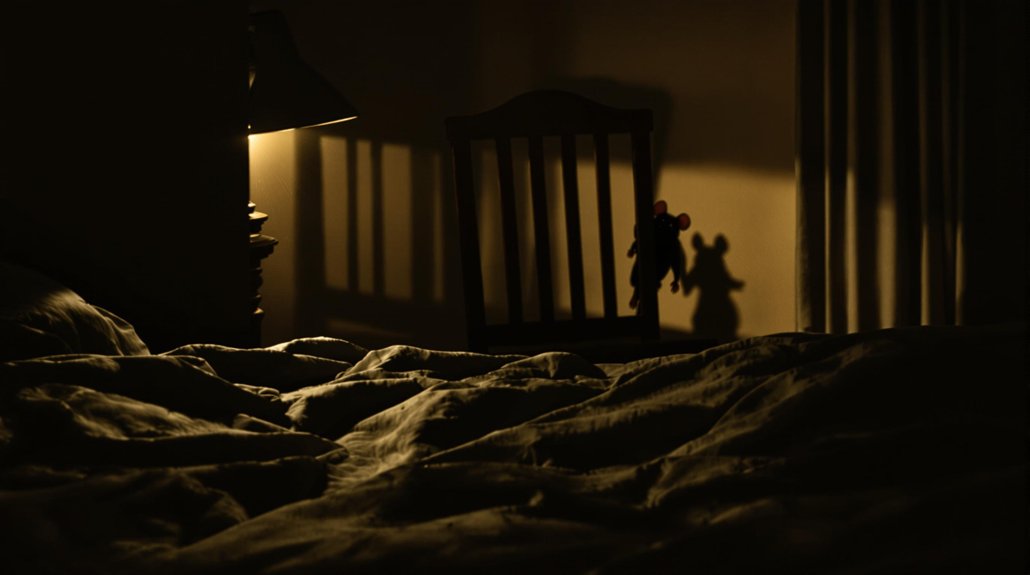
Although rats are often viewed as pests, understanding their behavior is essential for effective management. Rats possess notable intelligence, which aids their survival in various environments. They learn quickly and can adapt their behaviors to avoid danger. This intelligence makes them resourceful in finding food and shelter. Additionally, rats are nocturnal animals, meaning they are most active during the night. This behavior allows them to search for food and move around with less risk from predators. By recognizing these traits, individuals can take steps to manage rat populations more effectively. Creating less favorable conditions for rats, especially during their active hours, can help prevent infestations and promote a healthier living environment for everyone.
The Role of Light in Nature
Light plays an essential role in the natural world, influencing the behavior and survival of various organisms. It affects how animals interact with their environment, including their cycles of activity. Many species rely on light cycles to regulate their daily routines, including feeding and mating.
- Light can help organisms avoid natural predators.
- It influences plant growth and photosynthesis.
- Animals may use light to navigate their habitats.
For example, nocturnal animals are active at night to escape daytime predators, while diurnal animals thrive in daylight. Understanding light's role in nature helps us appreciate its importance in maintaining ecological balance and supporting diverse life forms. By recognizing these interactions, we can better serve and protect our natural world.
Myths About Rats and Light
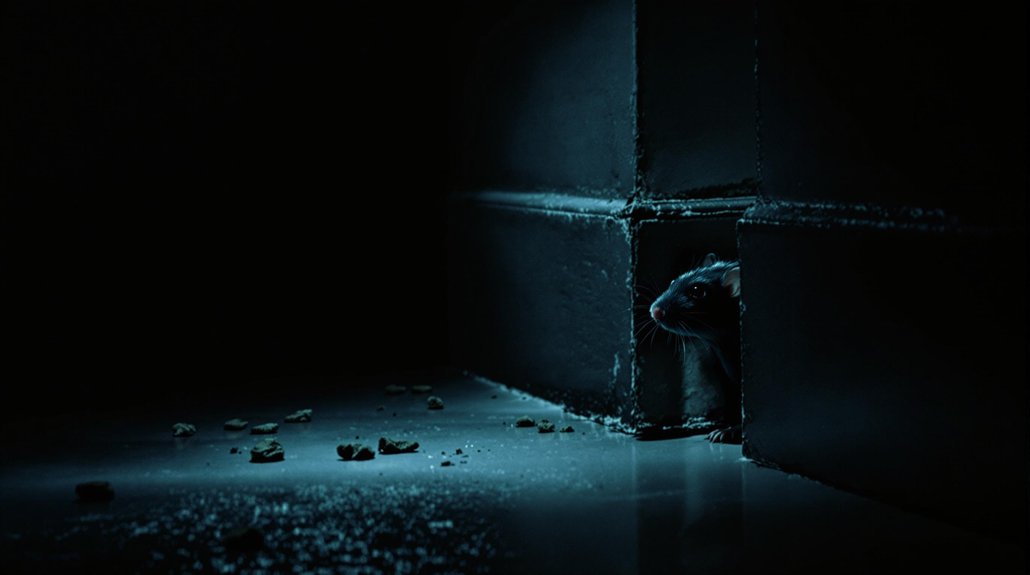
What misconceptions exist regarding the relationship between rats and light? Many people believe that light can effectively deter rats. This myth stems from various light misconceptions. However, studies show that rats can adapt to light conditions. They are not inherently afraid of light.
To clarify these myths, consider the table below:
| Myth | Reality |
|---|---|
| Rats avoid light completely | Rats can live in lighted areas |
| Bright lights repel rats | Rats can adapt to bright lights |
| Darkness is a safe zone | Rats thrive in various light conditions |
| Light prevents infestations | Effective control requires more than light |
Myth debunking is essential for understanding rat behavior. Knowledge helps in better pest management and serving communities effectively.
Research on Lighting Effects
Research on the effects of lighting on rat behavior reveals important insights into their adaptability. Studies indicate that light intensity can influence their nocturnal activity. Rats typically prefer dark environments, making them sensitive to changes in lighting.
Key findings include:
- Rats tend to avoid brightly lit areas, which may serve as a deterrent.
- Lower light intensity can encourage their movement and foraging behaviors.
- Continuous exposure to light may disrupt their natural routines and reduce their comfort.
Understanding these behaviors can help in creating environments less appealing to rats. While lighting is not a foolproof method, it may contribute to minimizing their presence in certain areas. This knowledge can guide efforts in serving communities dealing with rat infestations.
Other Deterrents for Rats
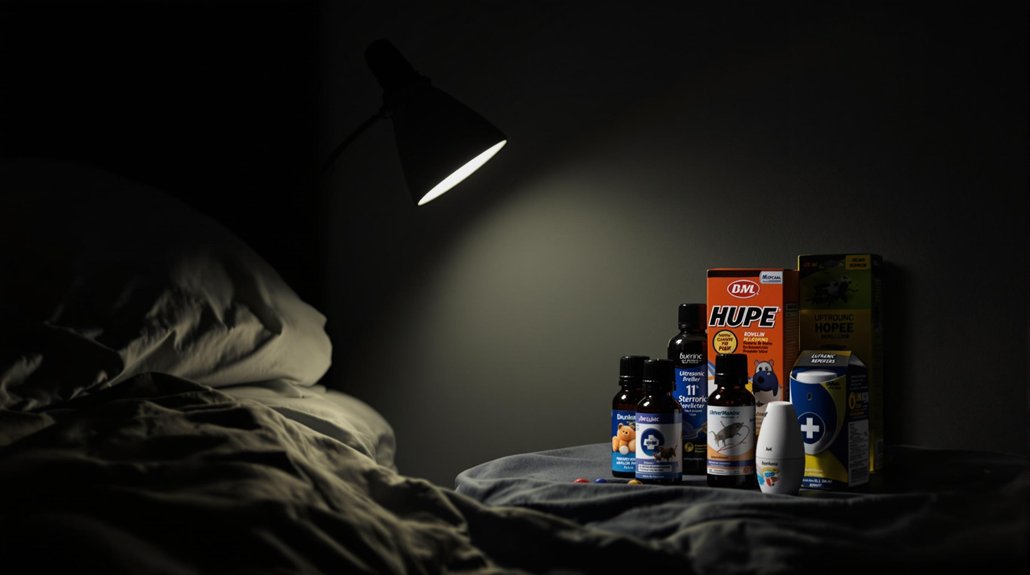
While lighting can influence rat behavior, there are other effective deterrents that can help manage rat populations. Natural repellents, such as peppermint oil and vinegar, can create an unpleasant environment for rats. These substances can be easily applied in areas where rat activity is noticed. Ultrasonic devices are another option. They emit high-frequency sounds that are uncomfortable for rats but inaudible to humans. Placing these devices in key locations can discourage rats from entering your space. Combining these methods may enhance their effectiveness. It is crucial to guarantee that food sources are eliminated and living areas are kept clean to further deter rats. Using these strategies can help create a less inviting environment for these pests.
Pros and Cons of Lighting
Although various factors can influence rodent behavior, the use of lighting as a potential deterrent for rats presents both advantages and disadvantages. Understanding lighting effectiveness requires consideration of rodent psychology.
Pros:
- Bright lights may disrupt rat activity, making areas less appealing.
- Consistent lighting can create a less comfortable environment for rodents.
- It provides peace of mind for individuals concerned about infestations.
Cons:
- Rats may adapt to light exposure over time.
- Illumination can attract other pests, complicating the issue.
- Over-reliance on lighting could delay effective prevention strategies.
Effective Rat Prevention Strategies
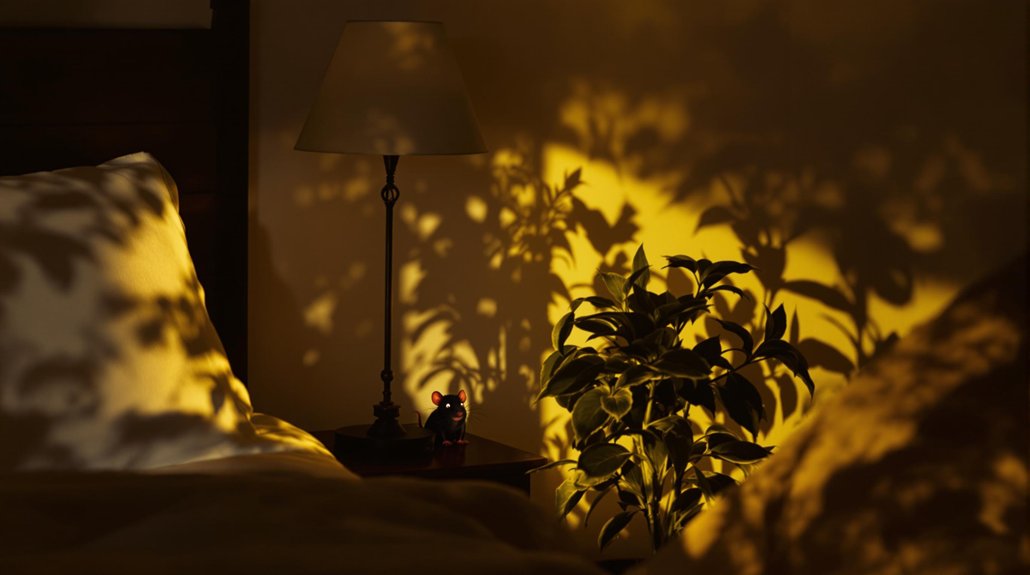
Effective rat prevention starts with maintaining clean surrounding areas. This reduces food sources and nesting sites for rats. Additionally, sealing entry points in buildings can help keep these pests out.
Clean Surrounding Areas
Maintaining clean surrounding areas is essential for preventing rat infestations. Effective cleanliness practices can greatly reduce the likelihood of attracting these pests. By focusing on surrounding maintenance, we can create an environment that is less appealing to rats. Here are three key strategies to implement:
- Regularly dispose of trash and food waste.
- Keep outdoor areas free of clutter and debris.
- Seal any gaps in fences or walls to limit shelter.
These simple actions not only promote hygiene but also serve the community by enhancing public health. By prioritizing cleanliness and maintenance, we can contribute to a safer environment for everyone. Taking these steps guarantees that our surroundings remain rat-free and protects the well-being of all who share the space.
Seal Entry Points
Sealing entry points is essential for preventing rat infestations. To protect your home, start with entry point identification. Look for gaps, cracks, and holes in walls, doors, and windows. Rats can squeeze through very small openings, so be thorough in your inspection. Once you identify these entry points, use effective sealing techniques. Fill gaps with materials such as steel wool or caulk, which rats cannot chew through. Install door sweeps and screens to cover vents and openings. Regularly check these areas to verify they remain sealed. By taking these steps, you create a barrier that keeps rats out and contributes to a healthier living environment for everyone. Your efforts make a difference in serving your community by preventing pest issues.
Environmental Considerations
Environmental factors play an essential role in rat behavior. Exposure to light can influence how rats adapt their habits and preferences. Understanding these aspects helps in creating effective strategies for rat control.
Light Exposure Impact
Light exposure plays an essential role in influencing the behavior of various pests, including rats. Understanding how light interacts with their environment can help in rodent control efforts. Factors such as light intensity and the light spectrum are significant in determining their activity levels.
- Light Intensity: Brighter lights may deter rats by creating an uncomfortable environment.
- Light Spectrum: Different wavelengths can affect rat behavior in unique ways.
- Duration of Exposure: Continuous light may disrupt their natural habits and routines.
Rat Behavior Adaptation
While many factors influence rat behavior, their ability to adapt to environmental changes is particularly notable. Rats exhibit various adaptive behaviors that help them thrive in different settings. One key aspect is their nocturnal habits, which allow them to avoid predators and seek food during the night. This adaptability enables them to respond quickly to changes in their environment, such as light exposure. For example, if they encounter bright lights, they may shift their activity patterns or find shelter in darker areas. Understanding these behaviors can help in developing effective strategies for managing rat populations. By recognizing their adaptive nature, we can better address their presence and minimize their impact on our living spaces.
Habitat Preferences Shift
As urban areas expand and natural habitats are altered, rats often adjust their habitat preferences to thrive in new environments. These habitat changes influence their behavior and increase their nocturnal activities. Understanding these shifts is essential for effective pest management.
Key factors influencing rat habitat preferences include:
- Food Availability: Rats are drawn to areas with abundant food sources, often found in urban settings.
- Shelter Options: Cracks, alleys, and clutter provide ideal nesting spots for rats.
- Human Activity: Increased human presence may encourage rats to adapt their behavior and explore new areas.
Expert Opinions on the Topic
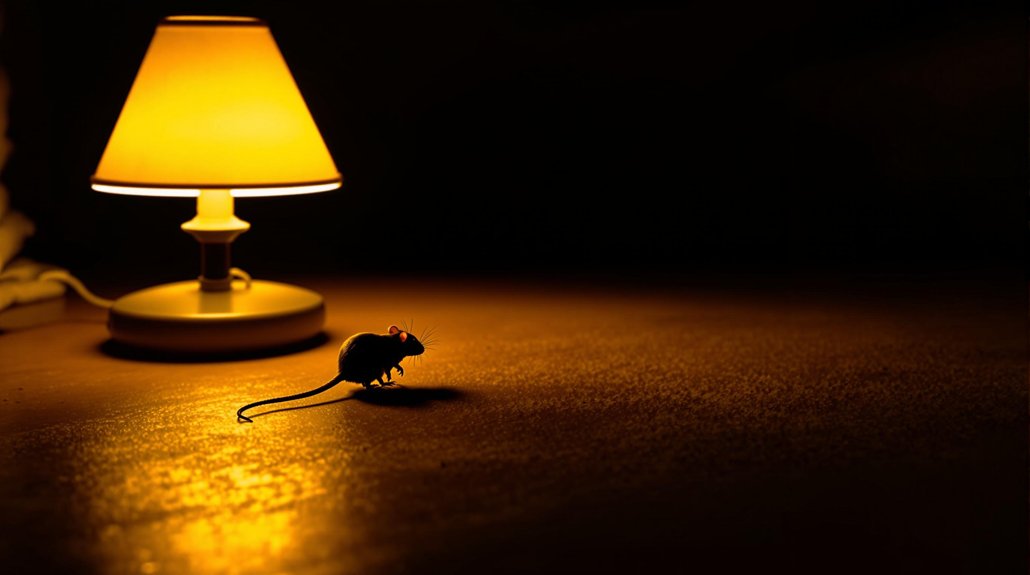
How effective is it to sleep with lights on for deterring rats? Expert insights suggest that light may not be a strong deterrent. Behavioral studies show that rats are adaptable creatures. They often feel safe in environments where they can hide, regardless of light.
| Factor | Impact on Rats | Expert Opinion |
|---|---|---|
| Light | Minimal | Not a strong deterrent |
| Noise | Moderate | Can deter some rats |
| Food Access | High | Attracts more rats |
Frequently Asked Questions
Can Bright Lights Attract Rats Instead of Repelling Them?
Curiously, bright lights may attract rats due to their light sensitivity and nocturnal behavior. While many assume light repels them, it can inadvertently create a more inviting environment, challenging common perceptions about rodent deterrence.
Do Different Light Colors Affect Rat Behavior Differently?
Different light colors can influence rat behavior. Light color psychology indicates that rats perceive colors differently than humans. Understanding these vision differences may help in creating environments that either deter or attract rats effectively.
How Does Lighting Impact Other Pests Besides Rats?
Lighting serves as a lighthouse, guiding pest behavior. Different lighting effects can deter or attract various pests, influencing their activities and movements. Understanding these dynamics can enhance strategies for effective pest management and prevention.
Will Leaving Lights on All Night Increase My Electricity Bill Significantly?
Leaving lights on all night can lead to increased electricity usage, resulting in higher bills. For better electricity savings, consider using timers or energy-efficient bulbs to minimize light usage without sacrificing safety or comfort.
Are There Specific Light Fixtures That Are More Effective Against Rats?
In the garden of protection, light and sound serve as vigilant sentinels. Motion sensors and ultrasonic devices are effective tools against rats, creating an unwelcoming environment that encourages these pests to seek refuge elsewhere.
